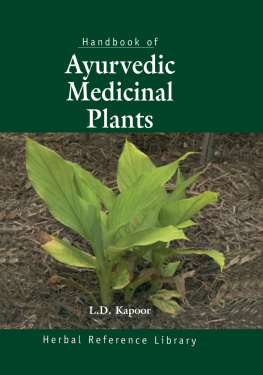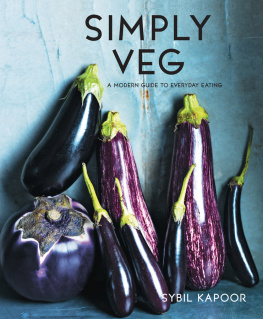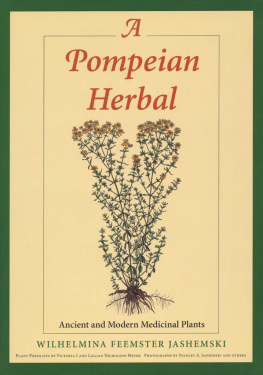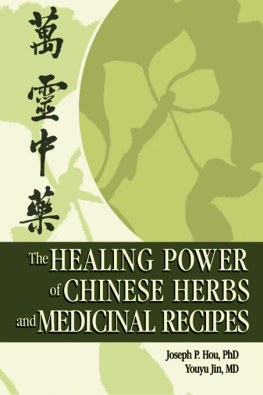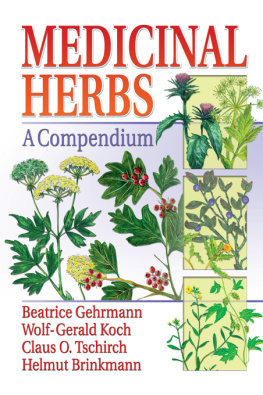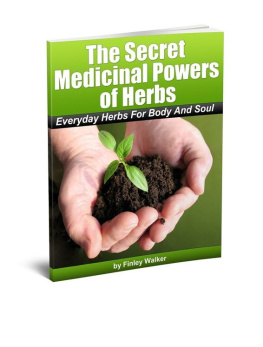Contents

Handbook of
Ayurvedic Medicinal Plants
L.D. Kapoor, Ph.D., F.I.A.C., F.A.S.P.
Scientist (retired)
National Botanical Research Institute, Lucknow
Council of Scientific and Industrial Research
India

Cover image courtesy of
T. Michael Kengla
GrassRoots Productions
Library of Congress Cataloging-in-Publication Data
Kapoor, L.D.
[CRC handbook of ayurvedic medical plants]
Handbook of ayurvedic medicinal plants / L.D. Kapoor.
p. cm.-- (Herbal reference library)
Previously published under the title: CRC handbook of ayurvedic medicinal plants.
Includes bibliographical references and index.
ISBN 0-8493-2929-9 (alk. paper)
1. Materia medica, Vegetable--India--Handbooks, manuals, etc. 2. Medicine, Ayurvedic--Handbooks, manuals, etc. I. Title. II. Herbal reference library series.
RS180.I3 K365 2000
615.3210954dc21
00-049360
This book contains information obtained from authentic and highly regarded sources. Reprinted material is quoted with permission, and sources are indicated. A wide variety of references are listed. Reasonable efforts have been made to publish reliable data and information, but the author and the publisher cannot assume responsibility for the validity of all materials or for the consequences of their use.
Neither this book nor any part may be reproduced or transmitted in any form or by any means, electronic or mechanical, including photocopying, microfilming, and recording, or by any information storage or retrieval system, without prior permission in writing from the publisher.
The consent of CRC Press LLC does not extend to copying for general distribution, for promotion, for creating new works, or for resale. Specific permission must be obtained in writing from CRC Press LLC for such copying.
Direct all inquiries to CRC Press LLC, 2000 N.W. Corporate Blvd., Boca Raton, Florida 33431.
Trademark Notice: Product or corporate names may be trademarks or registered trademarks, and are used only for identification and explanation, without intent to infringe.
First pulished by CRC Press LLC 1990
Transferred to Digital Printing 2010
2001 by CRC Press LLC
Herbal Reference Library edition
No claim to original U.S. Government works
International Standard Book Number 0-8493-2929-9
Library of Congress Card Number 00-049360
Publishers Note
The publisher has gone to great lengths to ensure the quality of this reprint but points out that some imperfections in the original may be apparent.
PREFACE
The ancient system of medical treatment is based on the rich experiences of innumerable Vaidyas over thousands of years, having trials on hundreds and thousands of human beings to its credit, to which no modern system of treatment in the world can ordinarily lay claim. This is one possible reason why this system has survived the critics through the ages and is still catering to the health needs of millions all over the world. The system is basically within the economic reach of the common individual because of natures bounty to mankind in herbal wealth of medicinal value.
The active ingredients of a drug, synthesized in the small unicellar laboratory of the leaf and then transported to reservoirs embedded within roots, fruits and leaves, bark, and flowers under photosynthetic influence, are natures gift to mankind. This alone speaks well for the inexpensive nature of the treatment afforded by traditional medicine in comparison to what the modern method of treatment through allopathy makes available and that, too, only to the affluent few in human communities.
The Indian materia medica contains over 2000 drugs, the majority of which are of vegetable origin. During the time of the Emperor Ashoka, the Hindu materia medica contained only 700 plants which were used by the Vaidyas. They were mostly cultivated and grown all over the country and their method of collection, manner of storage, and preservation were all well known. Since the number of drugs commonly used in those days was not very large, no elaborate descriptions were given for their identification. The student of medicine used to live with his guru in gurukulas (residential schools) and received practical training in the correct identification of drugs and plants and their collection at the proper time.
In the course of time, more and more vegetable herbs were gradually added to the indigenous materia medica, but unfortunately standards of purity and correct identification did not keep pace with this process of expansion.
The identity of a drug plant was based on the doctrine of signatures, viz., pashanbhed, meaning thereby the plant which can split a stone or grow through rocks. It is also indicative of dissolving or splitting of stones in the bladder or kidney. But there are quite a few plants which have the same diagnostic character as described above but which are different from each other and yet are called pashanbheds in different parts of India, such as Aerva lanata Juss.; Bergenia ligulata (Wall.) Engl., Coleus amboinicus Lour., Homonoia riparia Lour., Kalanchoe pinnata Pers., Ocimum basilicum Linn.,Rotula aquatica Lour., etc. Similarly, a Unani drug plant called gaozaban (like the tongue of a cow) may be Macrotomia benthami DC.; Onosma bracteatum Wall.; or Anchusa trigosa, Caccinia glauca Savi, etc. The doctrine of signatures was not often recorded, but the knowledge was handed down from guru to disciple or father to son where the Ayurvedic profession was confined to the family.
As time passed, the herbal gardens disappeared due to rapid colonization of rural forest areas. Much confusion has been created in the correct identification of such plants. Many plants are known by the same name, or many names are given to the same plant in different parts of the country. This has made matters more complex.
An attempt has been made in the present volume to describe some 251 plants, giving their different names in different languages in India and abroad. Their habitat, distribution and chemical constituents, and pharmacological or therapeutic uses and dosage as prescribed in the Ayurveda are also indicated. Pharmacognostic details, wherever possible, are also incorporated to confirm identification. A bibliography of references is included.
It is hoped that this information will now help correct the identification of Ayurvedic drug plants within the debris of confusion.
The vast country of India has varying agro-climatic and soil conditions ranging from arid to alpine zones, and every type of plant can be found growing in nature; further, many more exotics can be grown here. With its lush and diverse flora, India is rightly called the vegetable emporium of medicinal plants. The mountain range of the Himalayas has been known to be a repository of rare important medicinal plants since time immemorial. The great sages of Ayurveda fame used to assemble here for discussion and discourses on the theory and practice of Ayurveda and its materia medica.
Drug plants, which form about 90% of the materia medica of traditional medicine, play the pivotal role in the efficacy of the treatment. A wrong or dubious plant used in the formulations or treatment can give a bad name to the system itself.
This project was originally conceived by Dr. D. P. Sharma Ayurved Chakravarti, Pranacharya, who, in consultation with the late Dr. C. Dwarkanath and Prof. R. R. Pathak, worked on the format and sketched out a model of Ayurvedic description, properties, and action/uses for each plant, based on the literary records and personal experiences of leading practicing Ayurveds.

